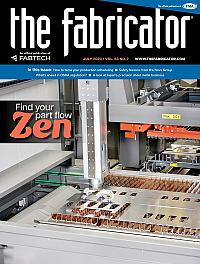Senior Editor
- FMA
- The Fabricator
- FABTECH
- Canadian Metalworking
Categories
- Additive Manufacturing
- Aluminum Welding
- Arc Welding
- Assembly and Joining
- Automation and Robotics
- Bending and Forming
- Consumables
- Cutting and Weld Prep
- Electric Vehicles
- En Español
- Finishing
- Hydroforming
- Laser Cutting
- Laser Welding
- Machining
- Manufacturing Software
- Materials Handling
- Metals/Materials
- Oxyfuel Cutting
- Plasma Cutting
- Power Tools
- Punching and Other Holemaking
- Roll Forming
- Safety
- Sawing
- Shearing
- Shop Management
- Testing and Measuring
- Tube and Pipe Fabrication
- Tube and Pipe Production
- Waterjet Cutting
Industry Directory
Webcasts
Podcasts
FAB 40
Advertise
Subscribe
Account Login
Search
Key metrics for metal fabricators looking to sell a manufacturing company
Business buyers and sellers relate to revenue, operational quality, and, especially, the people
- By Tim Heston
- July 11, 2023
- Article
- Shop Management

What do investors look at when purchasing a business? The metrics can be grouped into three areas: revenue, operations, and, perhaps most important, the people a fabricator employs. Muharrem Huner / DigitalVision Vectors / Getty Images
Remember the glory days, not too long ago, a pre-pandemic time of high multiples, low interest rates, and a white-hot M&A environment. Rising interest rates have put a damper on things, for sure, but that doesn’t mean fabricators looking to sell don’t have interested buyers—especially if those businesses are financially sound and seem to have a bright future.
I gathered that key takeaway after a wide-ranging conversation with Rob Wolfman, managing partner of Montage Partners, a Scottsdale, Ariz.-based private equity firm. Wolfman has been involved with numerous transactions over various sectors, including a 2019 acquisition of METALfx, a custom metal fabricator in Willits, Calif.
What exactly makes a fabricator attractive for a buyer? As Wolfman explained, answering this question starts with identifying strengths and weaknesses in three areas: revenue, operations, and people.
Considering revenue, the amount matters. Many investors group fabricators into two broad categories: a platform and an add-on to that platform. Platform companies need to have a certain critical mass, usually greater than $10 million in annual sales (though the number can vary depending on a fabricator’s niche). Very small companies might be agile and serve a handful of customers well, but they’re still inherently risky for investors—unless they’re looked upon as an add-on to an existing platform company.
Wolfman described a recent transaction METALfxA made of a Northern California fabricator with just a handful of employees. Purchasing it alone would have been too risky; purchasing it as an add-on company strengthened the platform company (METALfx) and its competitive position. The same thinking goes for the sources of revenue. A very small add-on company might have a shallow pool of customers in a specific niche—too risky for a buyer to purchase as a standalone firm, but it might complement a larger platform company nicely.
If investors purchase a fabricator as a platform company, though, they pay attention to the customer mix and revenue concentration. Is a shop’s customer mix diverse? Do demand patterns of different customers complement one another; that is, do demand peaks for customers in different markets come at different times, “smoothing out” overall demand? Also, what’s the nature of those market sectors? Do they serve necessities (think infrastructure and agriculture) or do they depend on discretionary spending (think recreational vehicles)? Does the operation serve a mix of sectors that together produce strong, sustainable revenue growth?
Related to this, what’s the win-bid ratio for new work? A low win rate might mean the shop isn’t as competitive as it should be, or perhaps it’s bidding in sectors that just aren’t a good fit.
Even more important is customer retention. What percentage of customers stay on for years? What are their order patterns? How predictable are they, and has the level of business from these customers increased or decreased over the years?
“A high customer retention level reflects you’re doing something right,” Wolfman said.
When investors look at operations, they scrutinize a shop’s capex funds for both new technology purchases and maintenance. A shop might invest in incredible technologies, but if they continually break due to lack of maintenance and training, there’s a problem.
The same goes for excessive rework, customer returns, and, more broadly, the shop’s reputation in the market. A poor reputation is a red flag, while respect from vendors and major customers goes a long way.
Investors also look at the mix of technologies a fabricator adopts and how it affects overall capacity, from the initial quote to the final shipment. “These are the growth investments,” Wolfman said, “especially in automation. And we look at the potential business this new technology unleashes. What’s the sales pipeline look like?”
Investments might include software that streamlines sales, quoting, planning, programming, and collections. A shop might deliver orders extraordinarily quickly, but if it takes weeks for a customer to pay, that’s a problem for cash flow. So is excess inventory, especially for work-in-process and finished goods, as well as a low number of inventory turns. Sure, the pandemic has created more of a “just in case” mentality, but inventory still drains cash.
Lead times are also critical. Say a fabricator has an extraordinarily productive shop with high-velocity part flow, though it still quotes lead times of more than six weeks—why? If it’s mainly because of an order backlog, that’s great, as long as it’s not too excessive. A healthy backlog is just long enough to give a good revenue buffer for the shop, yet not so long as to make customers and prospects turn to competitors.
The workload is also enough to support a healthy amount of overtime. This can depend on the shop and its culture, but as Wolfman explained, a shop that offers a limited amount of overtime to its workforce can be appealing. “People like making time and a half for the work they do,” he said, adding that many employees want enough overtime to make extra money, but not so much as to throw their work-life balance off kilter.
If excessive lead times come from operational inefficiencies, though, that’s a problem. These can include shop floor issues like rework, but it can also include front-office mishaps like miscommunication and purchasing or supplier problems. And sure, shortages over recent years have led to delays, but were all those delays entirely unavoidable? What about alternative vendors? Are customers open to design or process tweaks to incorporate alternative components?
Consider operations and revenue together, and you get financial results—including the one investors usually look at first: earnings before interest, taxes, depreciation, and amortization (EBITDA). Suffering EBITDA might be a sign shop efficiency isn’t what it could be. The operation also might not have a handle on job pricing and payroll in this inflationary environment.
Regarding payroll, though, Wolfman emphasized that he’s not looking for a shop that squeezes more out of its available labor while avoiding wage hikes. Yes, getting more out of every payroll dollar matters, but employee retention matters much more. High employee turnover is a huge red flag.
Revenue and operations are important, of course, but it’s people who produce and refine them. And their knowledge matters. “As investors, we spend a significant amount of time focused on people,” Wolfman said. “No matter what technology you have, if you don’t have great people up and down the company—I can’t speak for other investors, but we’re probably not going to be the right fit.”
Are people on the front lines trained and given opportunities to grow, or are they just clocking in and pushing buttons all day? If the CEO were hit by a bus tomorrow, could operations continue? What’s the company doing to attract good people? Is the environment clean and (most important of all) safe?
Wolfman conceded that all this involves a lot of intangibles. It’s tough to measure shop culture precisely, but from an investor’s perspective, a good one adds tremendously to a company’s value.
About the Author

Tim Heston
2135 Point Blvd
Elgin, IL 60123
815-381-1314
Tim Heston, The Fabricator's senior editor, has covered the metal fabrication industry since 1998, starting his career at the American Welding Society's Welding Journal. Since then he has covered the full range of metal fabrication processes, from stamping, bending, and cutting to grinding and polishing. He joined The Fabricator's staff in October 2007.
subscribe now

The Fabricator is North America's leading magazine for the metal forming and fabricating industry. The magazine delivers the news, technical articles, and case histories that enable fabricators to do their jobs more efficiently. The Fabricator has served the industry since 1970.
start your free subscription- Stay connected from anywhere

Easily access valuable industry resources now with full access to the digital edition of The Fabricator.

Easily access valuable industry resources now with full access to the digital edition of The Welder.

Easily access valuable industry resources now with full access to the digital edition of The Tube and Pipe Journal.
- Podcasting
- Podcast:
- The Fabricator Podcast
- Published:
- 04/16/2024
- Running Time:
- 63:29
In this episode of The Fabricator Podcast, Caleb Chamberlain, co-founder and CEO of OSH Cut, discusses his company’s...
- Trending Articles
Tips for creating sheet metal tubes with perforations

JM Steel triples capacity for solar energy projects at Pennsylvania facility

Are two heads better than one in fiber laser cutting?

Supporting the metal fabricating industry through FMA

Omco Solar opens second Alabama manufacturing facility

- Industry Events
16th Annual Safety Conference
- April 30 - May 1, 2024
- Elgin,
Pipe and Tube Conference
- May 21 - 22, 2024
- Omaha, NE
World-Class Roll Forming Workshop
- June 5 - 6, 2024
- Louisville, KY
Advanced Laser Application Workshop
- June 25 - 27, 2024
- Novi, MI


























